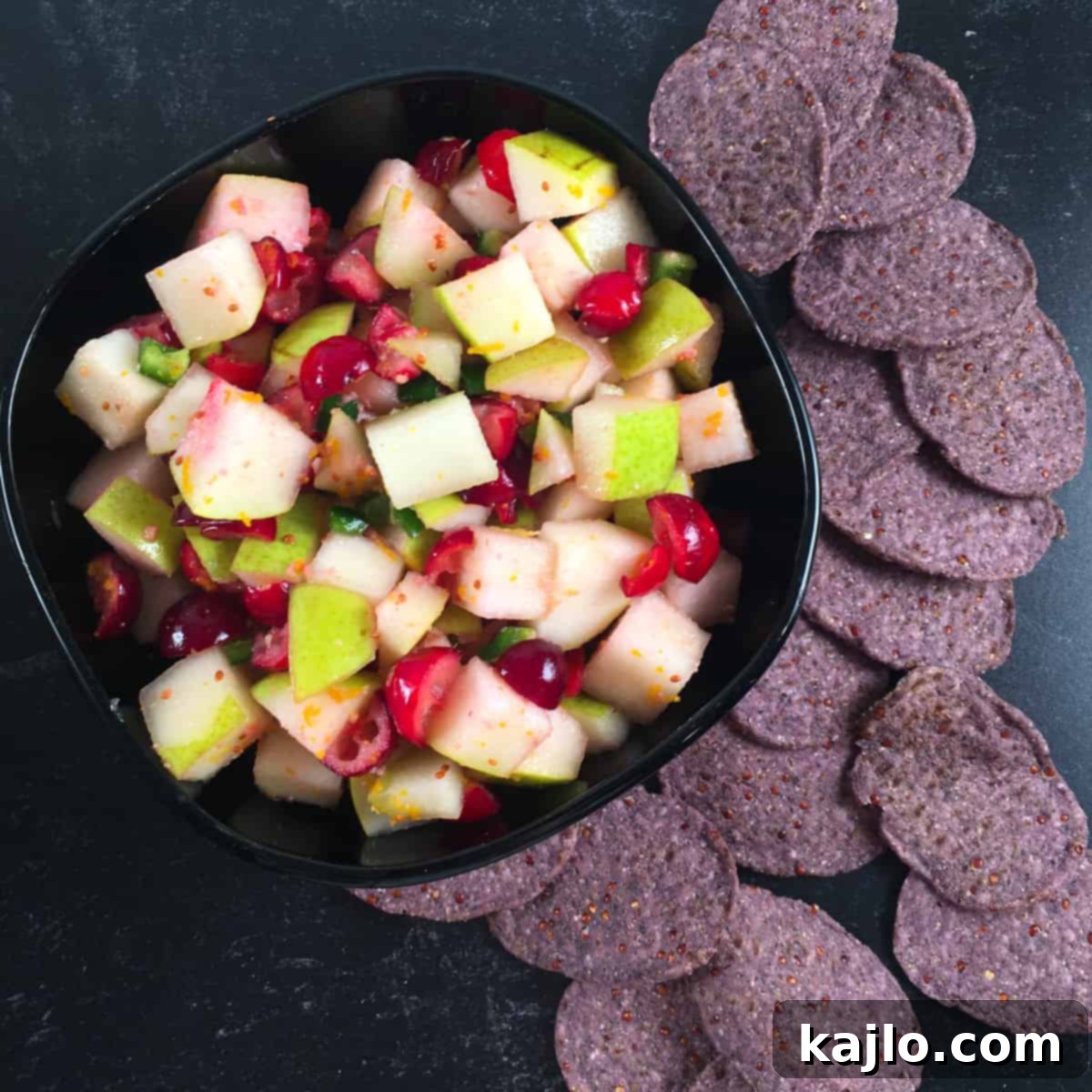Is salsa healthy and good for weight loss? This is a common question, and the answer is a resounding yes, with one important caveat. While a large bowl of salsa paired with a mountain of tortilla chips might not be the most effective strategy for shedding pounds, salsa on its own stands out as a high-volume, low-calorie food. This article delves into the nutritional benefits of salsa and presents a delightful recipe for low calorie salsa for weight loss that pairs wonderfully with lean proteins, transforming ordinary meals into extraordinary healthy delights. Prepare to fall in love with this easy homemade salsa recipe, which is naturally vegan, low in fat, and gluten-free, making it an inclusive choice for almost any dietary preference.
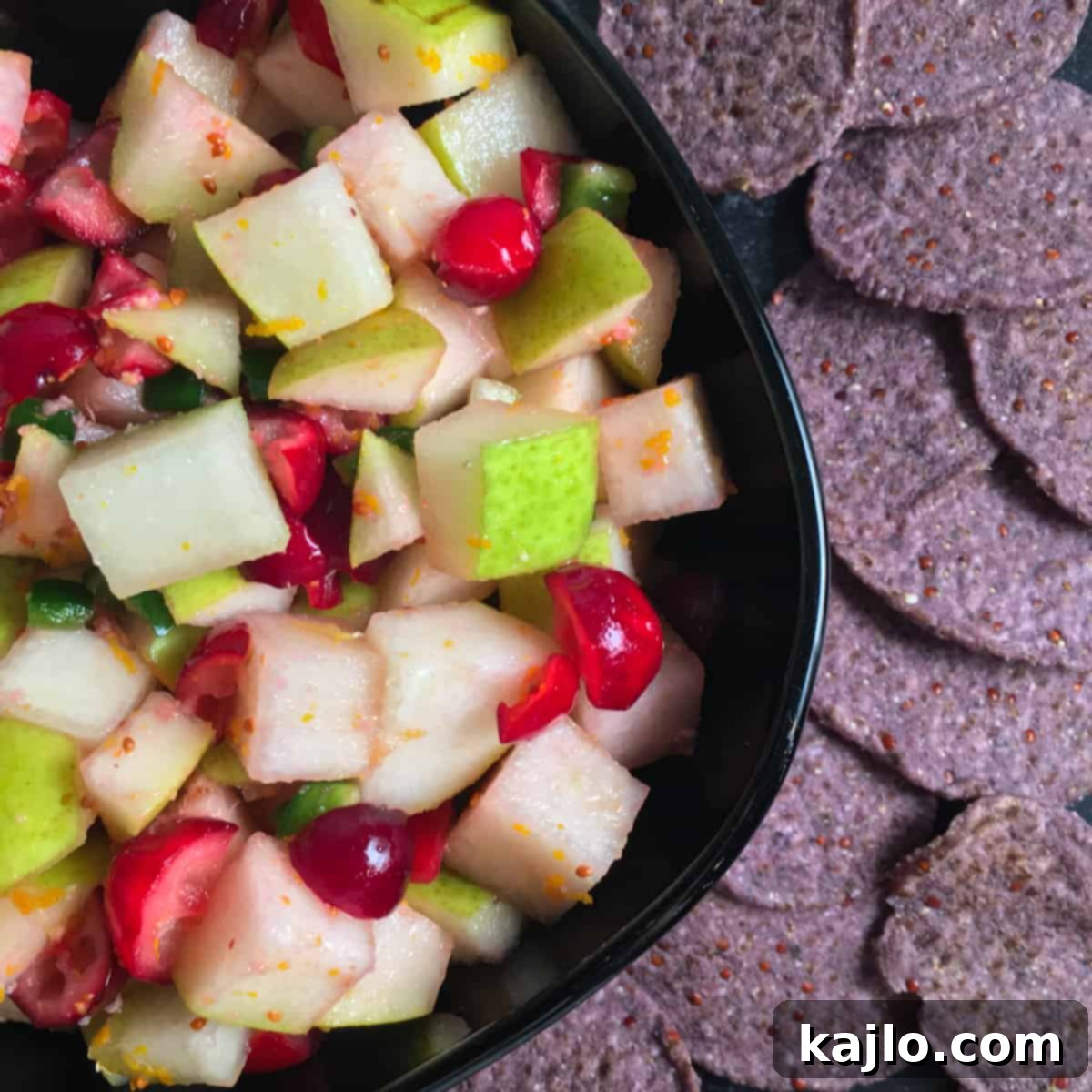
Unveiling the Truth: Salsa and Weight Loss Benefits
Many people ponder the link between salsa and weight loss. It’s worth noting that “salsa” can refer to more than just a delicious dip! If we’re talking about salsa dancing for weight loss, it’s an incredibly fun and energetic form of aerobic exercise that can significantly contribute to fat burning and cardiovascular health. But when it comes to the food itself, salsa offers an array of benefits that make it an excellent addition to a healthy diet.
Fundamentally, salsa is a vibrant concoction brimming with fresh fruits and vegetables. In most scenarios, I confidently assert that salsa is indeed good for you. It’s a fantastic way to boost your daily intake of essential nutrients without piling on excessive calories. The natural sweetness, tang, and spice of salsa make it an incredibly versatile condiment, capable of enhancing a wide variety of dishes.
However, the typical manner in which many consume salsa—scooping it up with generous portions of tortilla chips—often negates its inherent health advantages. It’s these calorie-dense chips, frequently eaten in excess, that can derail weight loss efforts. The salsa itself remains a low-calorie marvel, standing out as one of the healthiest dips for tortilla chips, if consumed in moderation with appropriate dippers.
So, if you’ve ever found yourself asking, “Is salsa fattening?” or “Is salsa unhealthy?“, as a dietitian, my definitive answer is no. Embrace and enjoy a flavorful tomato salsa, a refreshing mango salsa, a hearty salsa with black beans, or any other variety that tantalizes your taste buds. Each version typically offers a wealth of nutritional goodness, making them excellent choices for individuals mindful of their weight and overall health.
While traditional tomato salsas often contain the lowest calorie count, I would argue against singling out one “best salsa for weight loss.” Instead of obsessing over finding the absolute lowest-calorie option, focus on choosing a salsa that features flavors you genuinely enjoy and, crucially, contains no added sugar. This approach ensures sustainability and pleasure in your healthy eating journey. (Of course, if you’re following a specific dietary plan like a low-carb keto diet, you’ll need to select a skinny salsa dip that aligns with those particular requirements, often focusing on fresh, non-starchy vegetables.)
The Role of Salsa in Satiety and Portion Control
One of salsa’s unsung heroes in the realm of weight loss is its ability to promote satiety. Being high in water content and often rich in dietary fiber from its fruit and vegetable components, salsa helps you feel full and satisfied with fewer calories. This “volume eating” strategy is key for weight management, as it allows you to enjoy substantial portions without overconsuming energy. Incorporating salsa into your meals can naturally reduce the intake of higher-calorie sauces and dips, making it easier to adhere to your dietary goals.
📋 Salsa Calories: A Closer Look at What You’re Eating
Understanding the caloric content of salsa helps to highlight why it’s such a smart choice for weight management. How many calories in one cup of salsa? According to nutritional databases like Cronometer, a typical cup of store-bought tomato salsa contains a mere 75 calories. This figure impressively showcases salsa’s low-energy density.
Our featured salsa for weight loss recipe further exemplifies this, with one serving delivering just 64 calories, approximately 12.7 grams of net carbohydrates, and a minimal 0.2 grams of protein. These numbers solidify salsa’s reputation as an exceptionally low-calorie food, making it an ideal companion for virtually any meal.
❓ Why is Salsa So Low in Calories?
The secret to salsa’s low-calorie profile lies in its fundamental composition. At its core, salsa is primarily a blend of fresh fruits and vegetables, devoid of calorie-dense additives like oils, sugars, or flours. Unlike many other condiments or dips that rely on saturated fats or refined carbohydrates for flavor and texture, salsa derives its richness from naturally hydrating produce and its inherent fiber content. You’re not consuming significant amounts of energy-dense fats or excessive carbs; instead, you’re nourishing your body with fluid-filled produce, vital nutrients, and satiating fiber. This makes it a fantastic choice for adding flavor and volume to your meals without compromising your calorie goals.
⭐ Nutritional Powerhouse: Vitamins and Minerals in Salsa
Beyond its low-calorie nature, salsa is a nutritional powerhouse. What are the health benefits of salsa? The specific nutrients found in salsa will naturally vary based on the type, brand, or homemade recipe you choose. However, the homemade low-calorie salsa recipe detailed below provides an excellent snapshot of the rich nutritional benefits per serving:
- Vitamin C: Contributing 10.4% of the Daily Value (DV), Vitamin C is a potent antioxidant crucial for immune function, skin health, and protecting cells from damage.
- Vitamin A: Providing 0.5% DV, Vitamin A, along with Vitamin C, acts as a vital antioxidant, supporting vision and immune health.
- Potassium: With 131.2 mg, potassium is essential for maintaining healthy blood pressure, fluid balance, and proper nerve and muscle function, all contributing to a healthy heart.
- Calcium: Delivering 6.3% DV, calcium is fundamental for strong bones and teeth, as well as crucial for muscle function and nerve transmission.
- Iron: Offering 1.4% DV, iron is vital for oxygen transport in the blood and overall energy levels.
Furthermore, salsa often contains a bounty of non-essential phytonutrients, such as flavonoids, which are plant compounds known for their potential health-promoting properties. For instance, the humble jalapeño pepper, a common salsa ingredient, contains capsaicin. This compound is not only responsible for the pepper’s characteristic heat but may also offer a minuscule metabolic boost. Beyond its chemical composition, salsa is also a naturally hydrating food, thanks to its high water content from fresh produce. And, at least in my humble opinion, its deliciousness is a health benefit in itself, making healthy eating more enjoyable and sustainable!
🥘 Crafting Your Perfect Salsa: Ingredients for Weight Loss
The beauty of salsa lies in its endless possibilities for creating delicious flavor combinations. When considering the ingredients for salsa designed for weight loss, the emphasis is on fresh, whole foods that are low in calories but high in flavor and nutrients. Here’s the specific shopping list for our featured cranberry-pear salsa recipe:
- Frozen Cranberries: Unsweetened frozen cranberries are a fantastic base, offering a tart counterpoint and allowing you to enjoy this dish outside of cranberry season. Their natural tartness is balanced beautifully by the pears, eliminating the need for any added sugars.
- Fresh Pears: Pears bring a natural sweetness and delicate texture, providing the primary sweet element in this fruit salsa without relying on processed sweeteners.
- Grated Fresh Ginger: Ginger adds a warm, spicy, and aromatic note, complementing the fruit flavors and offering its own host of digestive benefits.
- Jalapeño: This pepper introduces a kick of heat, which can be adjusted to your preference by removing or keeping the seeds.
- Orange Juice: Freshly squeezed orange juice provides a bright, citrusy acidity that ties all the flavors together.
- Orange Zest: The zest intensifies the orange flavor, adding a fragrant and complex citrus note.

You’ll find the precise quantities for each ingredient in the detailed recipe card at the conclusion of this article. Utilizing unsweetened frozen cranberries is a brilliant trick, enabling you to prepare this vibrant dish any time of the year, irrespective of cranberry season. The natural sweetness derived from fresh pears in this particular salsa negates any need for added sugars, contributing to its health-friendly profile.
To prepare this straightforward salsa, you’ll need only a few basic kitchen tools: a good quality knife for chopping, a lemon or citrus squeezer for the orange juice, and a zester or fine grater for the ginger and orange zest. No elaborate or expensive kitchen equipment is necessary to create this quick, easy, and incredibly flavorful salsa!
🔪 How to Make Low Calorie Salsa: A Simple Guide
Creating this delicious, low calorie salsa for weight loss is surprisingly simple and requires minimal effort. Here’s a step-by-step guide to bring this vibrant condiment to life:
- Begin by taking the frozen cranberries out of the freezer just as you are ready to start your chopping. They will naturally defrost while you prepare the other ingredients, so there’s no need for pre-thawing. The slightly softened, mushy consistency of thawed frozen fruit is actually ideal for creating a wonderful salsa texture. Carefully quarter the frozen cranberries. Next, take the pears (cored but unpeeled for extra fiber and nutrients) and cut them into a ½-inch dice or smaller (approximately 1.27 cm). If you prefer a finer, pico de gallo-style fruit salsa, aim for very small, uniform pear pieces. Finally, finely chop the jalapeño. For a milder salsa, be sure to remove the seeds and the white pith; for more spicy heat, you can leave some or all of the seeds in.
- Next, prepare your aromatics and citrus. Grate the fresh ginger using a fine grater. Then, using your zester, carefully remove the bright orange zest from your orange, avoiding the bitter white pith beneath. After zesting, squeeze some fresh juice from the orange using your citrus squeezer.
- Now, all that remains is to combine everything. In a medium bowl, gently stir all of your prepared ingredients together until well combined. For the best flavor, refrigerate the salsa for at least 30 minutes to an hour before serving, allowing the individual flavors to meld and marry into a harmonious blend. The waiting is the hardest part!
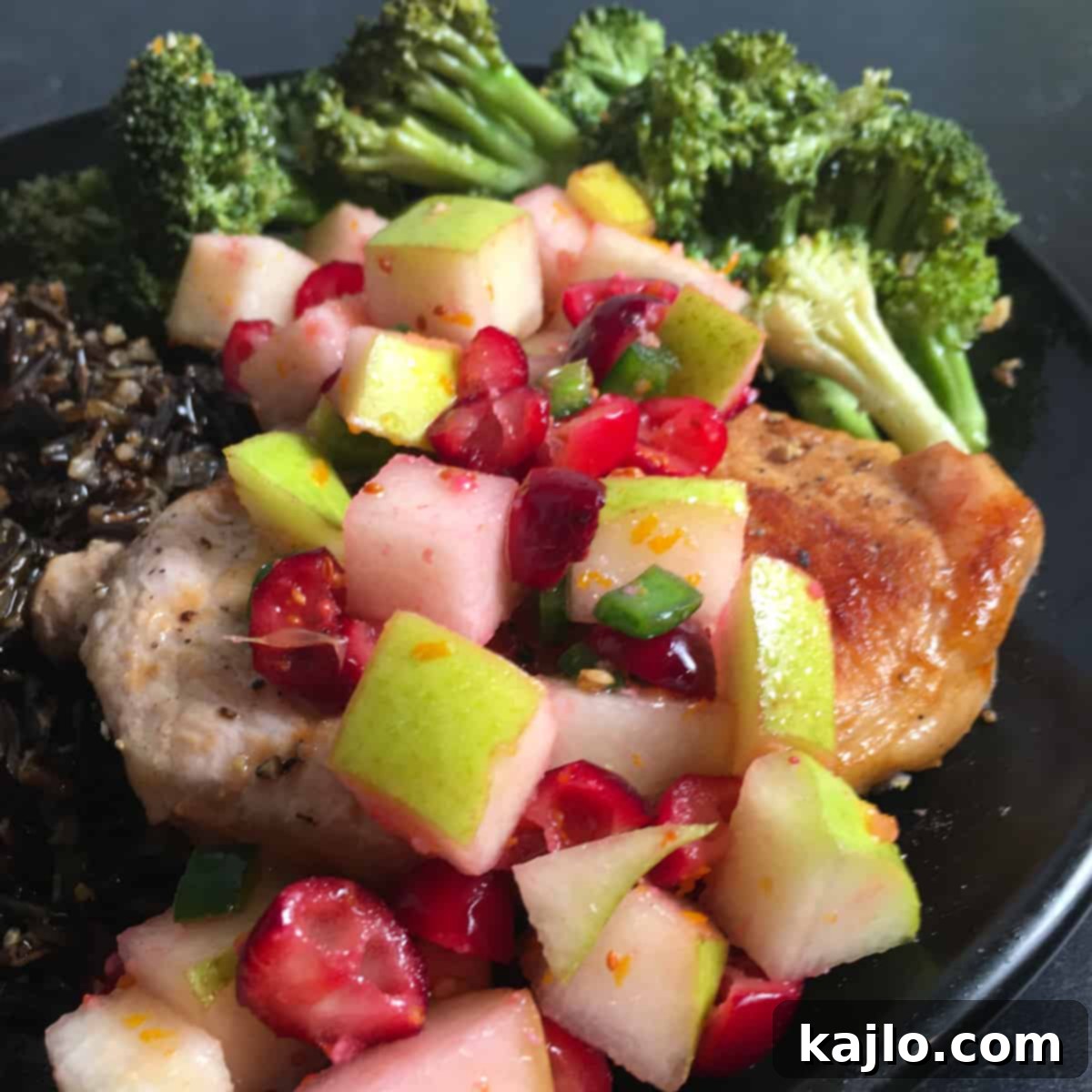
🌡️ Storing Salsa Leftovers: Tips for Freshness
Proper storage is key to enjoying your homemade salsa for days. You can store fresh homemade salsa in an airtight, covered container in the refrigerator for up to 3-4 days. It’s important to note that fresh salsa (especially uncooked varieties) should not be frozen, as the high water content of the fresh produce will cause it to become mushy and lose its desirable texture upon thawing. Be aware that homemade salsas containing certain ingredients, such as pears, apples, or avocado, may experience some browning if not consumed within one day due to oxidation. While some tomato-based salsas are suitable for canning for long-term preservation, fresh fruit salsas and pico de gallo varieties are generally not recommended for canning due to their acidity and composition.
🍅 Best Foods to Eat with Salsa for Weight Loss
The beauty of salsa, especially a low-calorie version, lies in its versatility as a flavor enhancer. What to eat with salsa for weight loss? Here are some creative and delicious low calorie ways to eat salsa that will keep your meals exciting and healthy:
- Lean Proteins: Elevate your dinner by serving this sweet and tart condiment over grilled pork loin, baked chicken breast, roasted turkey, pan-seared tempeh, or flaky white fish. The vibrant flavors of the salsa complement these proteins beautifully, adding moisture and taste without extra fat or calories.
- Whole Grains: Use salsa to infuse flavor into plain whole grains such as quinoa, brown rice, or couscous. This is a fantastic alternative to richer additions like margarine or butter, providing a burst of freshness and nutrients.
- Low-Carb Dippers: Ditch the high-calorie chips and opt for healthier, low-carb dippers for your salsa. Think crisp bell pepper sticks (any color!), refreshing jicama slices, crunchy cucumber rounds, or celery sticks. These options provide a satisfying crunch and help keep your snack calorie-controlled.
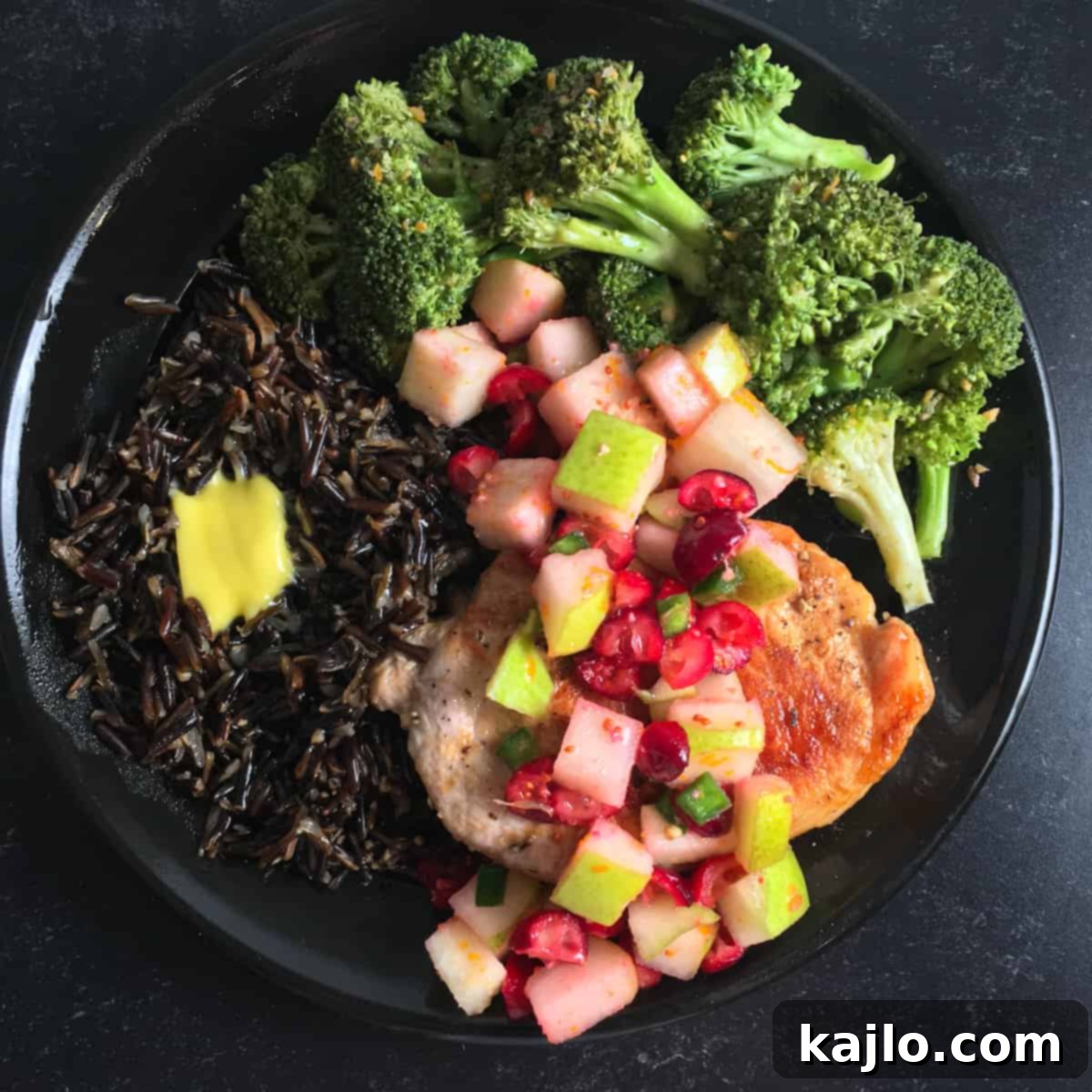
As illustrated here, this particular salsa is served over a perfectly seasoned boneless pork chop, accompanied by steamed broccoli and wild rice – a perfectly balanced and satisfying meal. This fruit salsa also makes an exceptional, naturally sweetened alternative to traditional canned cranberry sauce during holiday meals, offering a fresher, brighter flavor profile. Beyond this specific recipe, classic tomato salsa can be used in countless other ways, such as topping air fryer burgers, adding zest to sandwiches and wraps, or enhancing a simple breakfast of fried eggs. The possibilities are truly endless when you have a healthy, flavorful salsa on hand.
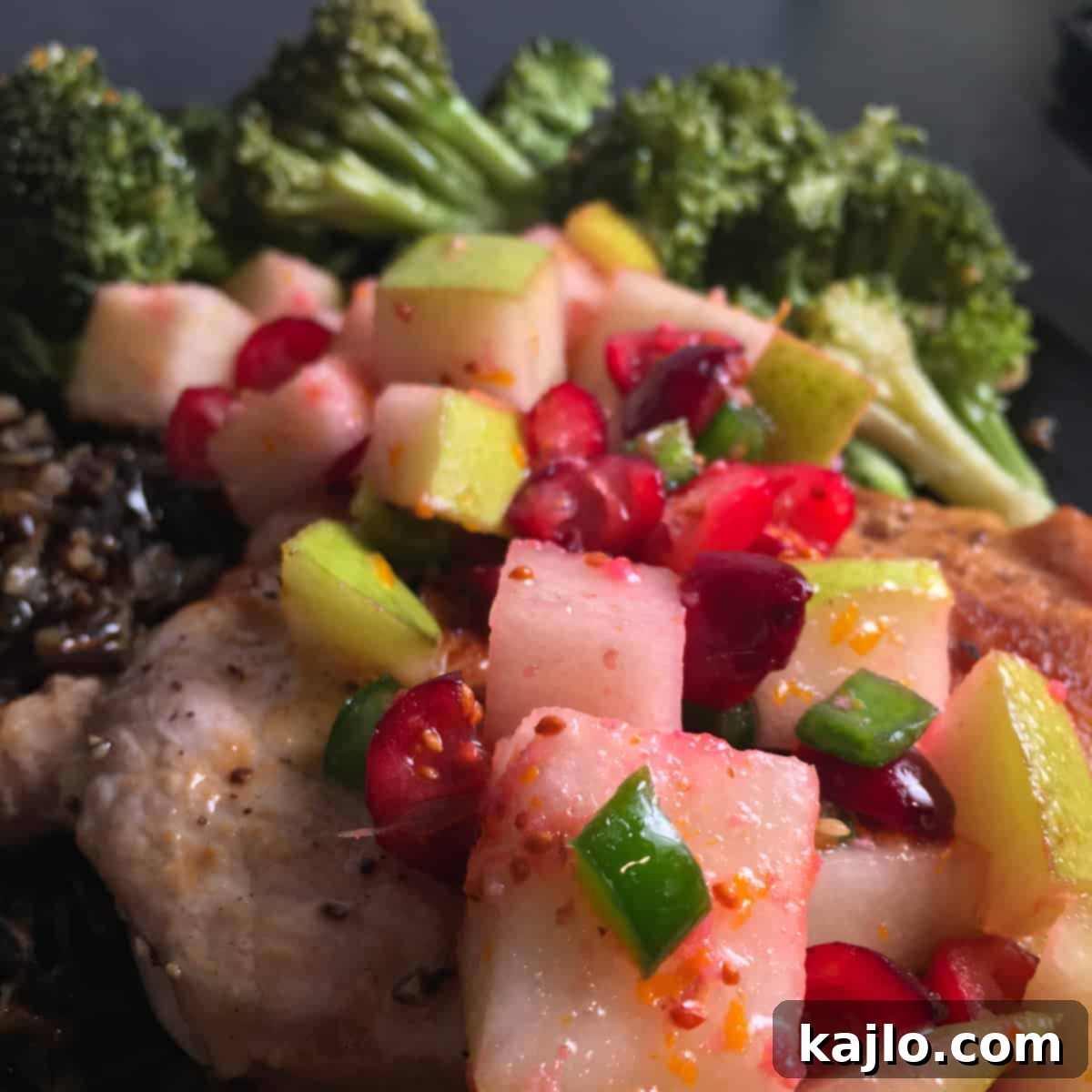
FAQs: Your Top Salsa Questions Answered
Let’s address some of the most frequently asked questions about salsa and its place in a healthy diet, particularly for weight loss.
How much salsa is a serving of vegetables?
Defining a “serving of vegetables” can vary slightly depending on the guidelines you follow. In general, according to MyPlate recommendations, one cup of cooked or raw vegetables counts as a serving. That’s quite a substantial amount of salsa! However, for practical purposes, especially within programs like the U.S. School Lunch Program, a ¼ cup of salsa is often counted as a vegetable serving (USDA). This smaller portion makes it easy to incorporate a vegetable serving into your meals without overdoing it.
What are some low calorie salsa brands?
Fortunately, most popular salsa brands available in supermarkets are inherently low in calories. You can confidently choose brands like Doritos salsa, Tostitos, Old El Paso, Ortega, Amy’s Kitchen, and Great Value, knowing that their primary offerings typically fit a low-calorie profile. The good news is that most homemade salsa recipes are also naturally low in calories, giving you even more control over the ingredients and nutritional content.
How to find low sodium salsa?
For those managing sodium intake, finding low-sodium salsa is crucial. According to the FDA, a product is considered “low sodium” if it contains 140 mg of sodium or less per serving, which typically translates to 5% Daily Value (DV) or less. To identify low-sodium options, always make it a habit to read the nutrition label on your favorite salsa brands. Many brands now offer explicitly labeled “low sodium” or “no salt added” versions, making it easier to make healthier choices.
How many carbs does salsa have?
Salsa is generally considered a low-carb and keto-friendly food, especially traditional tomato-based varieties. For instance, two tablespoons of fresh tomato salsa contain approximately 1.5 grams of net carbs per serving (as per Cronometer data). However, it’s important to be mindful that fruit salsas or those with added sugars will naturally have a higher net carbohydrate count than most unsweetened tomato-based salsas. Always check labels or calculate nutritional values for homemade recipes if you are strictly tracking your carb intake.
What are the cons of eating salsa?
While salsa is largely beneficial, there are a few potential downsides to consider. The primary concern with many commercially prepared salsas is their often-high sodium content, which can be an issue for individuals with high blood pressure or those monitoring their sodium intake. Additionally, some people find that the spicy ingredients commonly found in salsa, particularly chili peppers, can trigger heartburn or indigestion, making it “bad for their stomach.” Finally, and perhaps most commonly, the deliciousness of salsa often leads to overconsumption of its typical accompaniments, such as tortilla chips, which are generally high in calories and unhealthy fats. The real “con” often lies not in the salsa itself, but in how it’s consumed.
What is a good substitute for salsa?
The best substitute for salsa largely depends on your dietary needs and how you intend to use it. If you’re seeking a spicy kick, hot sauce can be a concentrated replacement for a small amount of salsa. For a rich, flavorful, and higher-calorie alternative, guacamole is a fantastic choice, offering healthy fats and a creamy texture. In some cooking applications, particularly those requiring a cooked tomato base, plain tomato sauce or crushed tomatoes can effectively replace salsa in recipes. Consider the flavor profile, texture, and nutritional goals when choosing a substitute.
👩🏻🍳 Other Delicious Salsa Recipes for Losing Weight
If you’ve enjoyed this low-calorie cranberry-pear salsa, you’ll be thrilled to explore other fresh and vibrant salsa recipes that are perfect for a weight-loss journey:
- Award-Winning Peach and Pineapple Salsa: A tropical explosion of flavor, perfect for summer meals.
- Best Salsa Substitutes: This article not only offers creative alternatives but also includes a fantastic sweet and spicy cherry peach salsa recipe!
- Strawberry Kiwi Salsa: Discover a refreshing strawberry kiwi salsa that pairs exceptionally well with Frozen Cod in the Air Fryer, creating a light and flavorful seafood dish.
Watch How to Make It!
(Video recipe content typically embedded here. Please refer to original source for video.)
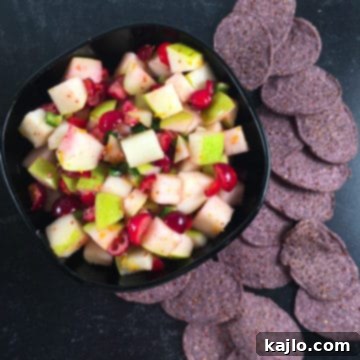
Low Calorie Salsa for Weight Loss (Easy Recipe!)
Summer Yule
Print Recipe
Pin Recipe
Ingredients
- 1 cup unsweetened cranberries (frozen)
- 2 cups pears, cored and chopped
- 1 teaspoon fresh grated ginger
- 1 jalapeno, seeded, finely chopped (keep the seeds for a hot salsa)
- 1 tablespoon orange juice
- 1 teaspoon orange zest
Instructions
- Quarter the frozen cranberries and cut the unpeeled, cored pears into a ½-inch dice or smaller (1.27 cm). If you want a pico de gallo-style fruit salsa, chop the pears very small. Finely chop the jalapeno; remove the seeds if you want less spicy heat.
- Grate the ginger and zest the orange. Squeeze some juice from the orange.
- Stir all of the ingredients together. Refrigerate the salsa, allowing the flavors to meld and marry, until serving time. Enjoy!
Equipment
- Knife
- Citrus Squeezer
- Grater
Notes
💭 Expert Tips from Dietitian Summer Yule
This is a level 1 recipe (may support fat loss). For weight loss purposes, what you eat salsa with is more important than the salsa itself. Salsa is a low-calorie fruit and vegetable-packed food that can flavor many delicious and light dinners.
There are endless produce combinations you can use for a 5-minute salsa (or 10-15 minutes, depending on how fast you chop). It’s an easy way to increase your fruit and vegetable intake and add volume to meals without many calories.
Many recipes using cranberries contain a lot of added sugar. Using pears to sweeten the cranberries here instead of corn syrup brings the calories down and the fiber up! That’s one of the wonderful things about homecooking- you get to decide exactly what goes into the food.
Nutrition information is for one serving.
nutrition info disclaimer
All recipes on this website may or may not be appropriate for you, depending on your medical needs and personal preferences. Consult with a registered dietitian or your physician if you need help determining the dietary pattern that may be best for you.
The nutrition information is an estimate provided as a courtesy. It will differ depending on the specific brands and ingredients that you use. Calorie information on food labels may be inaccurate, so please don’t sweat the numbers too much.
“To taste” means to your preferences, which may have to be visual to follow food safety rules. Please don’t eat undercooked food x
Nutrition
Join our community! Subscribe for all of the latest and greatest recipes, and follow me on Facebook, Pinterest, Instagram, and YouTube!
